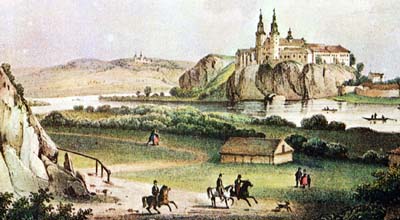|

Krakow's Ancient Benedictine Abbey of Tyniec
The spectacular Benedictine abbey in Tyniec upon the
riverbank on the western outskirts of today’s Krakow, some
twelve kilometers upstream from the Wawel Royal Castle,
boasts glorious and dramatic history of nearly 1000 years
rich in eventful episodes.
Founded in 1044 by Duke Casimir I the Restorer (Kazimierz I
Odnowiciel), then
Poland’s ruler, the Tyniec abbey used to command the
approach to the country’s capital city through the Wisla
(Vistula) river valley. The fortified monastery on a steep
hill was a hard nut to crack for the enemy, so small wonder
that it often suffered their revenge. Mongols burnt it down
in the 12th century, Swedes in the 17th century, and Russians in
the 18th century when the Tyniec Abbey was a crucial stronghold
of the first Polish national uprising.
Yet otherwise Benedictine monks have lived and worked here
peacefully for nearly a millennium. In the Middle Ages the
learned friars provided education to young royalty in
addition to their other numerous labors. Little was left of
the original 11th-century monastery as first it was replaced
by Gothic structures and next by the 16th-century
Renaissance buildings given a Baroque facelift in the 17th
century. Also the abbey's present Baroque church dates from
the 17th century.
In March 2017 the Tyniec Abbey has been officially named
Poland's Monument of History.
The Tyniec Abbey of today
The Tyniec Benedictines run a guest house with all the
modern conveniences in one of the abbey's recently
refurbished buildings.
The church of the Tyniec abbey is a popular venue for
classical music concerts, notably the summer series of the
organ recitals.
There is a cafe and shop that sells Benedictine food
products such as honey, varied preserves, cheeses, and teas,
also beer and wine.
|
Krakow churches
Krakow numerous churches are architectural gems, art
hoards, and spiritual hubs
Wawel Cathedral
Poland's impressive national shrine dates from the 14th
century and shelters plenty of superb church art. The Sigismund Chapel is a masterpiece of the
Renaissance art and architecture. Giant Zygmunt bell of 1520 ranks with the world's largest. Most Polish kings are buried here together with the greatest
national heroes.
Basilica of the Virgin Mary's
Immense Gothic church, the city of Krakow's principal
temple since the 13th century, boasts the world's greatest Gothic sculpture among its many excellent works of art.
Huge stained-glass widows of the chancel date from the 14th
century.
Skalka Sanctuary
Poland’s second holiest shrine at the site of St.
Stanislav’s 1079 martyrdom. Splendid Baroque church and fine
monastery modeled on a Renaissance castle.
Bielany Monastery
Magnificent 17th-century Baroque hermitage complex atop
the Silver Mountain hovers over Krakow.
St. Norbert's Convent
Vast fortified complex on the Vistula river is home to
Krakow’s once powerful Premonstratensian Sisters since the 12th
c.
Sanctuary of Divine Mercy
Humble nun’s visions in the 1930s gave rise to a
world-wide spiritual movement inside the Catholic Church, ever
stronger nowadays, with the center in her Krakow convent.
|



